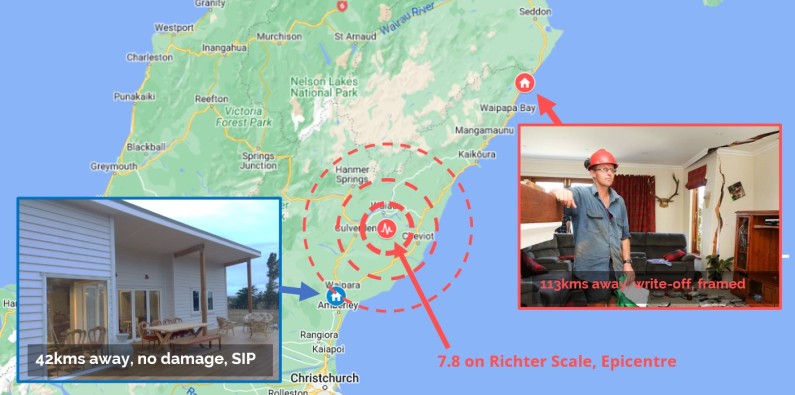Why SIPs Have an Advantage Over Timber Frames in Earthquake Resilience

New Zealand's geographical location along the Pacific Ring of Fire makes it highly susceptible to earthquakes. The country has experienced several significant seismic events, including the Christchurch Earthquakes of 2010 and 2011 and the Kaikoura Earthquake in 2016. These earthquakes caused widespread damage to buildings and infrastructure, highlighting the critical need for constructing earthquake-resistant structures. Ensuring the safety and resilience of buildings is paramount in protecting lives and reducing economic losses during such natural disasters.
Structural Rigidity and Performance
Structural Insulated Panels (SIPs) are prefabricated panels consisting of an insulating foam core sandwiched between two structural facings, typically oriented strand board (OSB). This construction method provides exceptional rigidity and strength. Research indicates that SIPs exhibit greater ductility, strength, and stiffness compared to traditional bracing systems used in timber frames. This suggests that SIPs can absorb and dissipate earthquake energy more effectively, reducing the risk of structural failure and damage.
Less Damage in Seismic Events
Observations suggest that SIPs sustain less damage during seismic events than commonly used bracing systems like plasterboard and plywood. The uniformity and continuous nature of SIPs contribute to their superior performance in distributing seismic forces evenly across the structure, minimizing localized stresses that can lead to damage. The ductility of the Formance system lies between totally rigid systems, like concrete, and more flexible systems, like timber framing. The Formance system has a great level of resistance to movement, but when it does yield it is not suddenly catastrophic. This means the remediation costs associated with a Formance building post-event are much less.
Real-World Evidence: Kaikoura Earthquake
The 2016 Kaikoura Earthquake, which measured 7.8 on the Richter Scale, provides compelling evidence of the superior performance of SIPs in seismic events. A home built with Formance SIPs located in Waipara, 47 kilometers from the earthquake's epicenter, sustained no damage and required no insurance claims. In contrast, many timber framed homes were destroyed; including a timber-framed house some 113 kilometers from the epicenter. This stark difference underscores the resilience of SIPs in real-world conditions. Read more about this terrible tragedy here.
Comparative Advantages
In contrast, timber frames, while flexible, can suffer from stiffness incompatibilities between conventional bracing and specifically designed elements. This mismatch may amplify damage during an earthquake, potentially compromising their seismic performance.
Comparison Table
Attribute |
SIPs |
Timber Framing |
Ductility |
2.0 |
3.5 |
Strength |
High |
Moderate |
Stiffness |
High |
Moderate |
Damage in Seismic Events |
Less damage |
More damage |
Construction Speed |
Faster (prefabricated) |
Slower (on-site assembly) |
Airtightness |
High |
Moderate |
Thermal Performance |
Excellent |
Good (with additional insulation) |
Durability |
High |
Variable |
Durability and Lower Remediation Costs
Anna Walsh's study at BRANZ highlights the long-term durability of SIPs under various climatic conditions in New Zealand. The research shows that SIPs maintain their structural integrity and performance over time, even in harsh environments. This durability is crucial for ensuring that buildings remain safe and resilient throughout their lifespan. Additionally, buildings constructed with SIPs tend to incur much lower remediation and repair costs after an earthquake compared to timber-framed buildings, making them a cost-effective choice in the long run.
Energy Efficiency
SIPs offer superior thermal performance compared to traditional timber framing. The continuous insulation provided by the foam core of SIPs minimizes thermal bridging, leading to better energy efficiency. This can result in lower heating and cooling costs for homeowners, making SIPs an attractive option for energy-efficient building designs.
Sustainability
While both SIPs and timber framing have environmental impacts, SIPs may have an edge in sustainability due to their energy efficiency and potential for reduced material waste during construction. The prefabrication process of SIPs allows for precise cutting and assembly, which minimizes waste compared to the on-site cutting required for timber framing.
Case Studies and Research
Various studies, including those by BRANZ and Natural Hazards New Zealand, support the advantages of SIPs in seismic resilience. The BRANZ study, which you can find in detail here, highlights the superior performance of SIPs in absorbing and dissipating seismic energy. Additionally, the Natural Hazards New Zealand article emphasizes the potential of SIPs to enhance building resilience in earthquake-prone areas.
Conclusion
The superior structural rigidity, reduced damage potential, and proven durability of SIPs suggest they may be a more resilient option than traditional timber framing in earthquake-prone areas. For homeowners and builders prioritizing safety and long-term performance, SIPs present a compelling case supported by various studies, including research by BRANZ and Natural Hazards New Zealand.
As the construction industry continues to evolve, the use of SIPs could become more prevalent, offering a robust and sustainable solution for building in regions susceptible to earthquakes.






